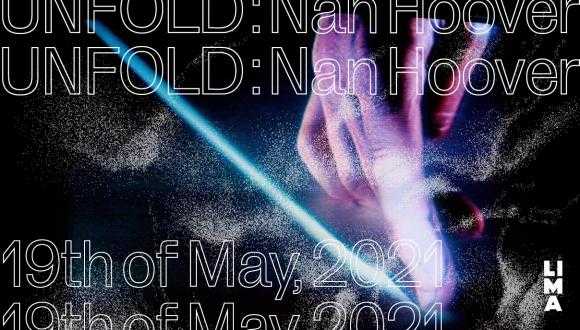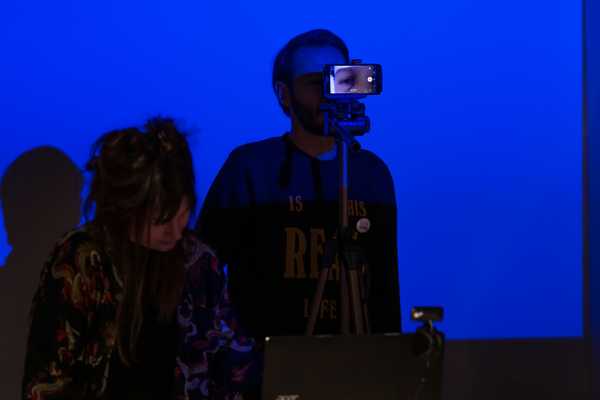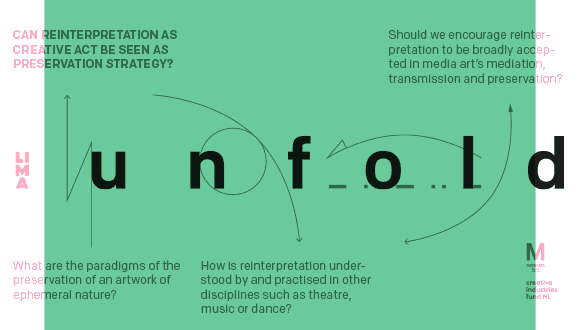UNFOLD Session #2
Reinterpretation as a creative act.
Within the context of the UNFOLD research project, LI-MA organised the public event UNFOLD #2 Reinterpretation as Creative Act and a network meeting on 14 September 2016. The second network meeting and second public event sought to answer the following questions: How would notions such as authenticity or authorship be affected by using reinterpretation as a transmission and mediation strategy for media art? and To what extent must reinterpretation be warranted by the original artist?
Participants
Adad Hannah (artist), Fransien van der Putt (radio artist and researcher), Suzanne Tuncha (choreographer), Claudia Roeck (conservator), Christian Sancto (researcher), Gabriella Giannachi (professor of performance and new media), Elisabeth Schimana, (composer, performer and radio artist), Sander van Maas (musicologist), Gaby Wijers (director of LI-MA), Lara Garcia Diaz (art theorist and researcher), Kristin Scheving (curator and project manager), Joost Rekveld (artist), Emma Panza (curator), Karin de Wild (art historian and researcher), Adam Lockhart (art historian and conservator), Martine Neddam (artist), Sarah Cook (art historian, curator and researcher), Hilde van den Dobbelsteen (LI-MA), Katja Kwastek (professor of art history), and Annet Dekker (Theorist, curator).
Meeting Summary
The second network meeting and public event took place on 14 September 2016 and gathered experts from different disciplines. Our research was now directed towards the notions of variability and repetition in digital and media art works.
As a result of the first encounters, we argue how reinterpretation refers for UNFOLD to artistic creation rather than a recreation or imitation of a historical artefact or event. An artistic creation is "a process – an activity – a thought". Thus, reinterpretation becomes an act of reflection that doesn’t aim at reproducing a work from the past in the present but rather activates a process, an activity and a thought towards the creation of a new work, which will coexist with other works as well. Adapting what choreographer Nicole Beutler suggests, we would argue that reinterpretation proposes a rearticulation of artistic thought as it unfolds in the original work.
Sub-questions Group 2:
The origin is confronted with the idea of a rhizome: What happens if we open the constellation thinking more about circular history than linearity? Can we still think from a beginning to an end? Or should we talk about different faces in the actualisation of the artworks? Preservation is always changing. It can reconcile opposites. But how much change is allowed? How does an artwork change and why? How can an artwork be preserved in different media platforms? How much history do we preserve?
As Lev Manovich writes in The Language of New Media (2002), “a new media object is not fixed, but can exist in potential infinite versions.” If the first group of questions was dedicated to the live qualities of media and digital art, its conclusion and awareness of the potentiality for reconsidering reinterpretation – not as a separate act or result, but rather as an element of an infinite network in which the artwork has no origin or end – opened up a new terrain that radically changed the second group of questions proposed in the first place.
During the second round of encounters with the members of the network, artist Martine Neddam described how, “concerning net art, reinterpretation is present in every act of transmission. […] Re-interpretation is at work everywhere, from the net page being reinterpreted by the local browser, to the pervasive circulation of memes online.” Neddam used her participation in the meeting to expose her doubts about the prefix ‘re-’ of reinterpretation: for her, it presupposes that there is one identifiable beginning or unity in the artwork. Neddam proposes to think instead about the ‘generative’ capacity of media art in an ecology that she presents as "generative transmission": “with the internet you can’t really separate the art from the circulation of the art, the piece from the museum.” As Neddam also notes in her interaction, ”in the internet you cannot separate the actual work from its transmission. Am I the artist or the museum? Am I creating or preserving? Am I giving access to the art or disseminating the art?"
Positioning the discourse within this framework, we decided to frame reinterpretation within another vocabulary that seemed to be permanently present in each of our discussions. The term reinterpretation is examined vis-à-vis others, like reimagining, regenerative, reenacting, remediation, retransmission, recreation, remake, remix, reactionisation, reactualisation, resonance, recycle, retrace, restaging or reperformed. It is noticeable how the prefix "re-" creates a conjunction within the different terms, and how it is precisely theis prefix that invokes memory practices yet is produced from the here and now. One main concern during this second phase of the project is precisely how to integrate all the knowledge from other disciplines within media art. It is agreed how difficult, and perhaps unproductive, it has been to try to come up with a concrete definition of reinterpretation to be further applied to all the disciplines. Rather than redirect all our attention into such a task, we proposed to examine what we address as the "dimensions" of a work. Here, reinterpretation would be one action (or dimension) between others. By doing so, we propose mapping reinterpretation within different dimensions and try to collect the touching points. Coming from a musicological perspective, Sander van Maas suggested to take in consideration the notion of time: how time changes and transforms; how time can also talk about process rather than a final object that seems finite. The discussion acquires the potentiality of talking about the "live circle of a work" rather than the "original" or the beginning: a rhizomatic or multidimensional space in which many subjects, temporalities and spaces coexist.
Crucial at this stage of the research was the incorporation of the theories by art historian Georges DidiHuberman, in which he states that “works of art do not have just one life. They have the life of their own making, but also many (after) lives after that.” He continues, “they live like ghosts in history. In order to understand artworks we should not only think of them in the context of artistic mastery, but also include their contemporary meanings.” During her intervention, Karin de Wild similarly suggested that the “crucial question is (especially for interactive artworks) how do we recreate the past and how can we stimulate re-engagement with it?" In other words, how do we remember the past? The cultural clock always ticks on, and we all know that only fragments of history will survive. Some elements will stay the same, others will become obsolete or mutate. In 2017 the social, cultural and technological context is fundamentally different from 20 years ago.
Curator Emma Panza revisited during her participation in the meeting her investigation of the relations and overlappings between performative practice and curatorial practice; working with the archive of De Appel (Amsterdam) allows her to search for inspiration, and to develop strategies. In that sense, approaching the archive presented an opportunity for Emma to investigate the ways in which she could “perform” the role of curator. Moreover, curator Sarah Cook proposed during this second meeting a theoretical framework around the notion (borrowed from Hanna Hölling) that all artworks could be conceived of as temporal objects, inhabiting specific "relative durations". As Hanna Hölling questions herself, “Can we conceive of artworks in terms of their temporal duration – as events, performances and processes? Can artworks, including the recent portion of artistic production as well as traditional artworks, be rethought in terms of time and their intrinsic temporalities? Why and how would it matter for their conservation?” This idea, next to keywords presented by Cook borrowed this time by Domenico Quaranta’s in his article "Lost in Translation" such as ‘fidelity’ and ‘transparency’, offered a new research terrain for the project: the opportunity to rethink traditional paradigms of conservation that regard objects as fixed and static entities. Indeed, changeability and impermanence, characteristics that were posed as problematic at the beginning of this project, were transformed now into conditions of possibility for media and digital art’s survival.
The incorporation of Annet Dekker’s investigation of storytelling as a means of navigating archived material was crucial at this point. First, she recounted the ways in which archived Geocities webpages were deployed by artists Olia Lialina and Dragan Espenschied. She related such strategies of preserving online cultures to storytelling techniques. Second, by selecting works by artist Erica Scourti – The Outage (2014) and The Dark Archive (2016) – she revealed dimensions of automated online archiving that exceed the subject of the archive’s own memory: as a result of this excess, the archive in turn becomes a site for the reinterpretation of everyday life through the production of new narratives. For Dekker, the question remains: How can storytelling be used as a strategy for preservation? Further investigation of the efficacies of such an approach would appeal to disciplines like archaeology, oral history, and ethnography, in which the analysis of storytelling has a more firmly established status as a research method.









